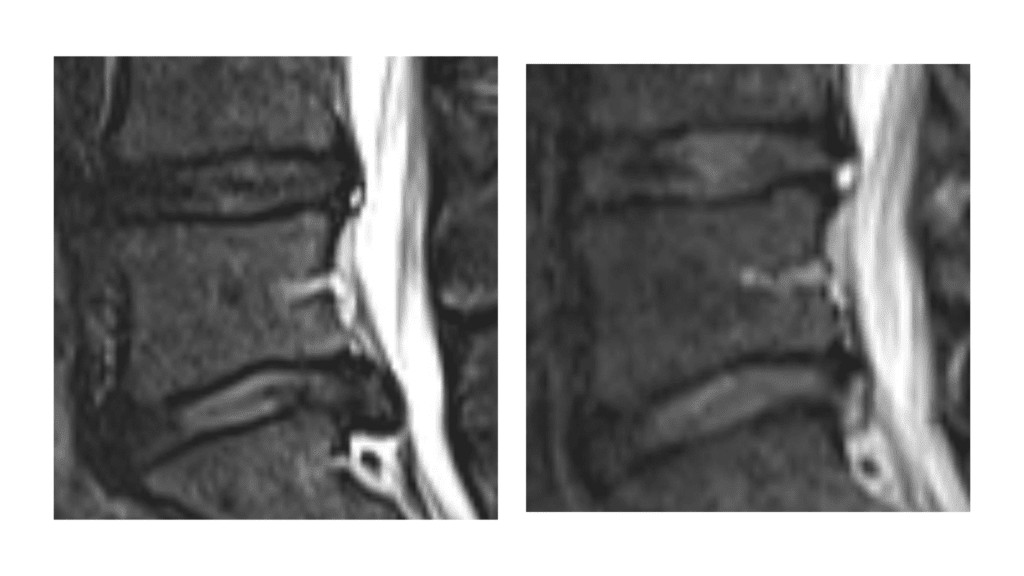Avoiding Surgery In CrossFit Athletes with Herniated Disc

Credit: Shutterstock
In this article:
A herniated disc is usually one of those things that just happen, either due to trauma or an “oops” moment. Prior to 2000, it was almost a sure thing you would have surgery to fix it, but that’s changed quite a bit with the development of modern interventional spine techniques.
Today we’ll explore the case of a woman who avoided surgery by getting an intradiscal PRP injection. Let’s jump in.
CrossFit Herniated Disc: How Karrah Got Injured
Discs act as shock absorbers between the spinal vertebrae. They are made from a tough outer covering called the annulus and a gel-filled center called the nucleus pulposus. When the outer annulus tears, the gel inside can squirt out. This is known as a disc herniation. It’s not the same thing as a disc bulge, in which the annulus is damaged but the nucleus is still contained.
Karrah was a 26-year-old woman with several years’ history of worsening low back pain. She was an avid CrossFit enthusiast at the time and noticed low back pain when she increased her training regimen. In particular, a double-under jump rope workout seemed to cause the initial issue. When she would impact the ground while jumping rope, she began to get zingers down her left leg.
Eventually, she stopped doing CrossFit and transitioned to bodybuilding, which helped. But when she couldn’t resist starting CrossFit again in March 2020, it was a kettlebell workout at a CrossFit gym this time that really aggravated her back. At that point, she began to get more intense numbness and tingling down her right leg. And in March of last year, she aggravated the injury again.
Avoiding Surgery In CrossFit Athletes with Herniated Disc
She tried chiropractic care and saw a sports medicine physician who recommended getting a corticosteroid epidural, but after further research, she declined. Chiropractic care seemed to help, but decompression therapy aggravated things.
If you go through physical therapy and fail to resolve your back and leg pain, the next step is usually an epidural steroid injection. The good news is that this can provide enough relief to buy time and allow your body to clean up the mess in your disc. But the bad news is that high-dose steroids can damage surrounding tissue and the body’s local natural repair cells. That’s why we stopped performing high-dose steroid epidurals about 15 years ago and switched to using platelet-based procedures.
Treating CrossFit Disc Herniation With PRP
Karrah first saw Regenexx certified physician, Dr. Markle, at our Colorado clinic in May of 2021. That June, Dr. Markle injected high-dose PRP into her herniated discs, then he used her own concentrated platelet products to give her an epidural and injections into the facet joints and ligaments. Take a look at her results below.

On the left at the bottom of the image is a large herniated disc (L5-S1). On the right, six months after the procedure her disc herniation is now greatly reduced in size. She initially reported 90% improvement, but after yet another CrossFit injury she’s down to 70%. Our current goal is to get her stronger working with a physical therapist and then determine whether she could benefit from another PRP treatment.
While some disc herniations can resolve with time, Karrah’s was there for a while — and it wasn’t changing. We believe that by injecting high-dose PRP inside and around the disc, we were able to improve the blood supply and increase the activity of the macrophages, which dismantle and remove herniated disc material. This approach is obviously better than surgery because it won’t leave the back wall of the annulus in a weakened state. Remember that the surgical approach removes part of the back wall, which can lead to an increased chance of recurrent hernias.
Explore more results from Regenexx patients.

If you have questions or comments about this blog post, please email us at [email protected]
NOTE: This blog post provides general information to help the reader better understand regenerative medicine, musculoskeletal health, and related subjects. All content provided in this blog, website, or any linked materials, including text, graphics, images, patient profiles, outcomes, and information, are not intended and should not be considered or used as a substitute for medical advice, diagnosis, or treatment. Please always consult with a professional and certified healthcare provider to discuss if a treatment is right for you.